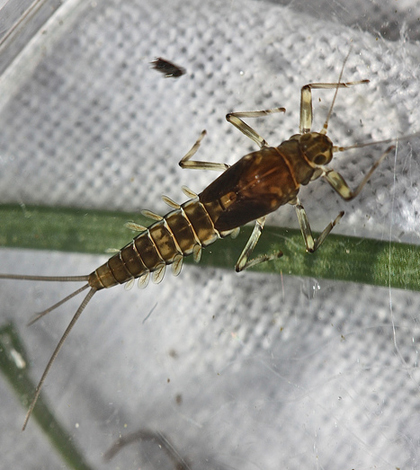Aquatic insects vulnerable to contaminant levels deemed safe by EPA

EPA water quality standards may not be protective of sensitive aquatic insects like mayflies (Credit: Bob Henricks, via Flickr)
Aquatic insects play important ecological roles in lakes and streams, but some scientists say the bugs’ susceptibility to contaminants like heavy metals rarely figures into the research the U.S. uses to establish water quality standards.
The U.S. Environmental Protection Agency determines acceptable levels of contaminants in water based on a library of lab research on how aquatic organisms react to controlled exposures to pollutants. Yet that library is thin on the impacts to insects, even though they’re often among the dominant groups in aquatic systems.
“The vast majority of the information that we have about what’s a safe contaminant and what concentrations might be safe of that particular contaminant are based on these laboratory toxicity tests, which routinely don’t include aquatic insects,” said Will Clements, a professor in the Department of Fish, Wildlife and Conservation Biology at Colorado State University.
And the laboratory tests on insects that are included have problems of their own. The tests often say that some species are resistant to toxic effects, despite field surveys of contaminated streams that suggest otherwise.
“There’s this incredible discrepancy between what we know takes place in the field and what we see in these laboratory toxicity tests,” Clements said. “They’re extremely tolerant based on laboratory tests, and extremely sensitive based on field observations.”
Clement’s lab has developed a toxicity testing method that better accounts for the ways that insects are exposed to stream contaminants in nature. A new study of this approach shows that at least some EPA standards for heavy metal concentrations may not be strict enough to protect sensitive species.
One reason that insect toxicology plays a smaller role in water quality standards is that the bugs are difficult to raise for research purposes. Other animals like fish are easier to culture, so they tend to take up more pages of the research literature.
Since researchers generally can’t grow insects in the lab, they have to pull test specimens from natural habitats. That practice might contribute to the discrepancy between lab tests and field observations, Clements said.
“The few laboratory experiments than have been done with aquatic insects tend to use the ones that you can see,” he said. “We tend to go out in the field and collect larger, more robust, more mature and therefore more tolerant organisms.”
Standard lab tests are also limited to measuring the effects of contaminants mixed into the water column. That neglects the additional exposure to contaminants that wild insects receive through eating tainted algae or detritus. Traditional tests are also relatively brief, generally lasting for just 96 hours, Clements said.
“We know with certainty that the toxicological effects of contaminants can occur over a much longer period of time,” he said. “Insects are not going to exposed only for four days in the field.”
The method that Clements has developed attempts to account for these shortcomings. First, test insects are collected in baskets filled with natural streambed gravel and cobble. The baskets are left in streams for 30 or 40 days while mayflies, stoneflies, caddisflies, midges and other insects of all ages and sizes colonize the gravel. When the researchers pull the baskets from the stream, they have a collection of species that looks reasonably like a natural community.

Insect-collecting gravel baskets on the streambed (Credit: Will Clements)
Back at Colorado State’s Stream Research Laboratory, the bug-laden gravel baskets are placed in microcosms that recreate flow conditions of a natural stream. These are oval, race-track shaped tanks with continuous flows regulated by paddle wheels.
Clements used this setup to assess the effects of copper and zinc on aquatic insect communities, the results of which were recently published in Environmental Science and Technology. Insects across several microcosms were exposed to controlled concentrations of copper, zinc or a combination of the two. Though the insects persisted through ten days of exposure to what the EPA has determined to be safe concentrations of zinc, that wasn’t the case for those exposed to the federal standard for copper.

Microcosms tank with current-controlling paddle wheel (Credit: Will Clements)
“The safe concentrations for copper don’t look like they’re protective for some of these aquatic insects,” Clements said. “Especially some of the really sensitive groups like the mayflies.”
Despite the apparent shortcomings of water quality standards when it comes to aquatic insects, there are signs that the EPA is coming around on the issue, Clements said. For example, the agency has recently developed water quality criteria for streams affected mountaintop removal mining that is based entirely on field data on aquatic insects.
“For those of us who have been critics of the traditional approach, I think it’s a pretty refreshing development in EPA that they’ve actually used these field data to derive a standard,” Clements said. “It’s pretty revolutionary from the way EPA has been establishing water quality criteria for the last 40 years now.”
Top image: EPA water quality standards may not be protective of sensitive aquatic insects like mayflies (Credit: Bob Henricks, via Flickr)





0 comments